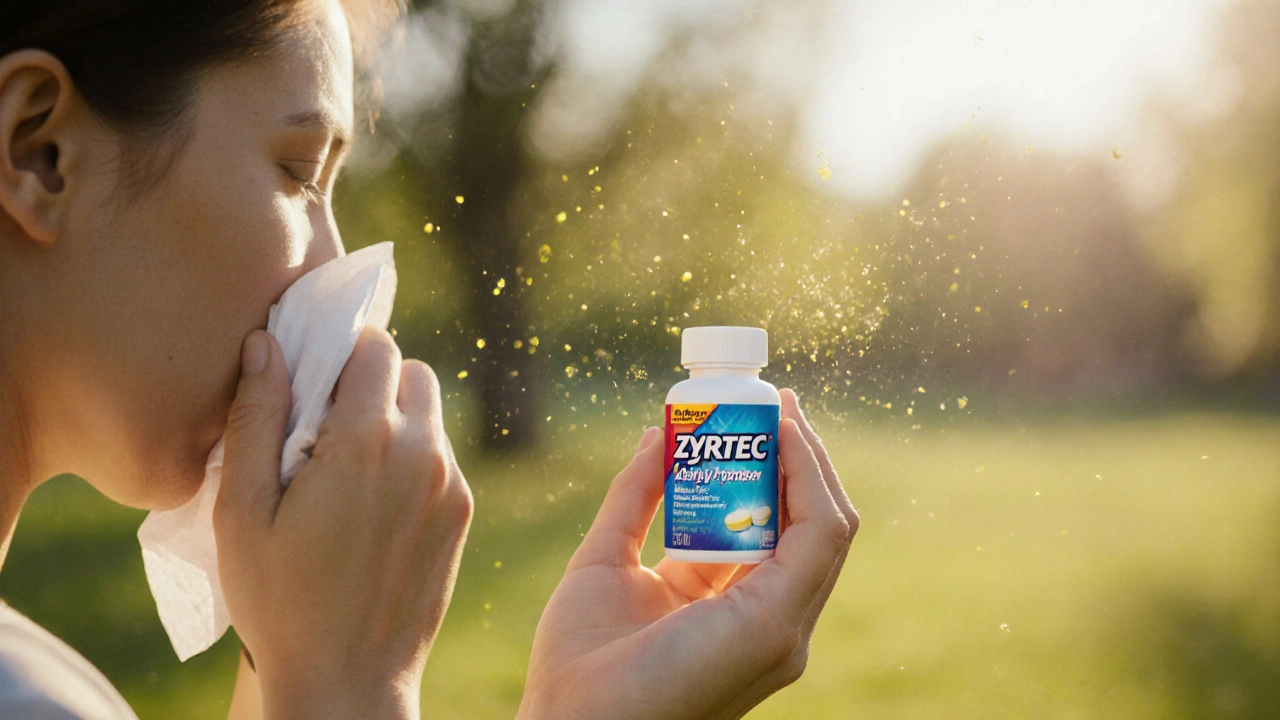Zyrtec vs OTC Antihistamines Comparison Tool
Key Factors to Consider
- Onset of Action: How quickly symptom relief begins
- Duration of Relief: How long the medication works before needing another dose
- Sedation Level: Risk of drowsiness or fatigue
- Age & Pregnancy Safety: FDA guidelines for children and pregnant individuals
- Cost: Average price per 30-tablet supply
Recommended Antihistamine
Medication:
Why It's Recommended:
Key Features:
Price (30 tablets):
Allergy season can feel relentless, and choosing the right antihistamine often means the difference between a calm day and a constant sneeze‑fest. Zyrtec alternatives are plentiful, but not all work the same way. This guide breaks down Zyrtec (cetirizine) and the most common over‑the‑counter options so you can pick the one that fits your symptoms, lifestyle, and health needs.
Key Takeaways
- Zyrtec offers fast onset and 24‑hour relief with low to moderate sedation.
- Claritin (loratadine) is truly non‑sedating but works a bit slower.
- Allegra (fexofenadine) provides the least drowsiness and is safe for most athletes.
- Benadryl (diphenhydramine) is the most sedating; best for short‑term night‑time use.
- Xyzal (levocetirizine) is a more potent version of cetirizine, ideal for severe hives.
What is Zyrtec?
Zyrtec is a second‑generation antihistamine whose active ingredient is cetirizine. It works by blocking H1 receptors, reducing the release of histamine that triggers sneezing, itching, and watery eyes. Approved by the FDA in 1995, Zyrtec is available in tablets, chewables, and liquid form, making it a go‑to for adults and children over six months.
Common OTC Antihistamine Alternatives
Claritin contains loratadine, another second‑generation antihistamine. It’s marketed as non‑sedating and is popular for workplace use because it rarely causes drowsiness.
Allegra offers fexofenadine as its active ingredient. The drug is chemically related to terfenadine, but it has been reformulated to avoid heart‑related side effects. Allegra is prized for its zero‑sedation profile.
Benadryl uses diphenhydramine, a first‑generation antihistamine. It can cross the blood‑brain barrier, causing strong sedation-making it useful for nighttime allergy relief or as a short‑term sleep aid.
Xyzal is levocetirizine, the active enantiomer of cetirizine. It delivers similar efficacy to Zyrtec but often with a slightly lower dose, which can be beneficial for patients sensitive to side effects.
Nasacort (triamcinolone) is a nasal steroid spray rather than an oral antihistamine. While not a direct competitor, it’s frequently paired with oral antihistamines for persistent nasal congestion.
How We Compare Antihistamines
To make an apples‑to‑apples comparison, we look at five core criteria that matter most to most users:
- Onset of action: How quickly symptom relief begins after the first dose.
- Duration of relief: How many hours the medication covers before another dose is needed.
- Sedation level: The likelihood of feeling drowsy or slowed down.
- Age & pregnancy safety: FDA labeling for children and pregnant people.
- Typical out‑of‑pocket cost: Price per 30‑tablet supply (average U.S. retail price in 2025).
Side‑by‑Side Comparison Table
| Medication | Active Ingredient | Onset | Duration | Sedation | Kids (min age) | Pregnancy Category | Avg. Price (30 tablets) |
|---|---|---|---|---|---|---|---|
| Zyrtec | Cetirizine 10mg | ~1hour | 24hours | Low‑to‑moderate | 6months (liquid) | B (compatible) | $13 |
| Claritin | Loratadine 10mg | ~2hours | 24hours | None (non‑sedating) | 2years | B | $12 |
| Allegra | Fexofenadine 180mg | ~1hour | 12hours | None | 12years | B | $15 |
| Benadryl | Diphenhydramine 25mg | ~30minutes | 4-6hours | High | 6months (liquid) | C | $9 |
| Xyzal | Levocetirizine 5mg | ~1hour | 24hours | Low | 6months | B | $16 |
Choosing the Right Antihistamine for You
If you need quick relief and can tolerate a little drowsiness, Benadryl’s fast onset makes it ideal for an occasional night‑time dose. For everyday work or school, Claritin or Allegra are smarter choices because they keep you alert.
When both nasal congestion and itchy eyes bother you, Zyrtec offers a balanced profile: a rapid start, a full day of coverage, and only mild sedation for most adults. If you have severe chronic hives (urticaria), Xyzal’s higher potency may give you that extra punch without jumping to prescription‑only options.
Pregnant patients often ask about safety. Both Zyrtec and Claritin fall into FDA Category B, meaning animal studies showed no risk and there are no well‑controlled human studies-generally deemed acceptable when benefits outweigh potential risks. Benadryl is Category C, so it should only be used under doctor guidance.

Side Effects & Drug Interactions to Watch
Second‑generation antihistamines (Zyrtec, Claritin, Allegra, Xyzal) share a low side‑effect profile: mild headache, dry mouth, or rare dizziness. They rarely interact with common medications, though caution is advised when combining with alcohol or sedatives because the modest drowsiness can add up.
First‑generation Benadryl is notorious for anticholinergic effects-dry mouth, urinary retention, and blurred vision-especially in older adults. It also intensifies the sleepy‑making impact of alcohol, benzodiazepines, and certain antidepressants.
Always check with a pharmacist if you’re on blood pressure meds, seizure drugs, or theophylline (as used for asthma). Some antihistamines can increase the blood level of these agents, leading to unexpected side effects.
Cost, Insurance & Availability
All five drugs are available over the counter, so insurance rarely covers them unless prescribed for chronic conditions like chronic urticaria. Bulk buying (e.g., 90‑tablet packs) can shave 20‑30% off retail price. Generic versions of cetirizine and loratadine are widely sold for under $8 per month, while brand‑name Allegra and Xyzal stay closer to $15‑$20.
For patients on a fixed income, the cheapest path is often the generic cetirizine (Zyrtec’s off‑brand) because it matches efficacy with the lowest price point.
Practical Tips for Maximizing Relief
- Take the pill with a full glass of water; food doesn’t affect most second‑generation antihistamines.
- Set a daily alarm if you need a 12‑hour drug like Allegra-missing a dose can cause a symptom rebound.
- Store liquid formulations in a cool, dark place to preserve potency.
- If you experience persistent drowsiness, switch from Zyrtec to Claritin or Allegra before considering prescription options.
- Keep a symptom diary for a week; note onset time, effectiveness, and any sedation. This data helps your doctor fine‑tune treatment.
Frequently Asked Questions
Can I take Zyrtec and Claritin together?
Generally no. Both block the same H1 receptors, so stacking offers no extra benefit and may increase side‑effects like headache. If one isn’t enough, talk to your doctor about a stronger prescription or adding a nasal steroid.
Is Zyrtec safe for my 2‑year‑old?
Yes, the liquid form is approved for children as young as six months. The pediatric dose is 2.5mg (¼ of an adult tablet) once daily, but always double‑check with your pediatrician.
Why does Benadryl make me so sleepy?
Benadryl is a first‑generation antihistamine that crosses the blood‑brain barrier, directly affecting the central nervous system. This is why it’s often used as a short‑term sleep aid but not ideal for daytime use.
Which antihistamine works best for exercise‑induced asthma?
Allegra (fexofenadine) has the lowest sedation profile, making it a favorite among athletes. It doesn’t interfere with beta‑agonist inhalers, but you should still carry your rescue inhaler.
Can I use a nasal spray instead of an oral antihistamine?
Nasal steroids like Nasacort target inflammation directly in the nose and are excellent for congestion, but they don’t relieve itchy eyes or hives. Many doctors recommend pairing a nasal spray with an oral antihistamine for full coverage.
Ultimately, the “best” antihistamine comes down to your specific symptoms, tolerance for drowsiness, and budget. Use the table above as a quick reference, try a low‑risk option first, and keep a short symptom log to fine‑tune your choice.







Johanna Sinisalo
October 9, 2025 AT 19:52Thank you for putting together such a thorough comparison. I appreciate the clear tables and the practical tips for everyday use. If you haven’t already, consider adding a quick note on how to rotate antihistamines to avoid tolerance buildup.
OKORIE JOSEPH
October 10, 2025 AT 18:06This guide is a waste of space and you clearly didn’t research the drugs
Lucy Pittendreigh
October 11, 2025 AT 16:19Honestly the article glosses over the ethical side of pushing cheap generics while ignoring patient safety you should care more about truth than sales
Nikita Warner
October 12, 2025 AT 14:32Thank you for the comprehensive comparison; it serves as an excellent reference for clinicians and laypersons alike.
I would like to highlight the importance of considering comorbid conditions such as asthma when selecting an antihistamine.
For patients with mild intermittent asthma, Zyrtec’s minimal sedative effect permits continued use of short‑acting bronchodilators without concern for additive CNS depression.
Conversely, first‑generation agents like diphenhydramine should be avoided in this population because their anticholinergic load may exacerbate bronchospasm.
The pharmacokinetic profile of cetirizine, with a half‑life of approximately 20 hours, supports once‑daily dosing which improves adherence.
When counseling pregnant patients, it is prudent to reference FDA Category B status, yet also to emphasize the paucity of robust human data.
In my practice, I frequently recommend the generic cetirizine formulation due to its cost‑effectiveness without compromising efficacy.
It is worth noting that the bioavailability of loratadine can be reduced by concurrent consumption of grapefruit juice, a fact often overlooked in patient education.
Additionally, fexofenadine’s absorption is markedly decreased when taken with high‑fat meals, an interaction that can be mitigated by advising administration on an empty stomach.
For individuals experiencing severe chronic urticaria, levocetirizine may offer a modest advantage in symptom control, though insurance coverage may dictate feasibility.
Nasal steroid sprays such as fluticasone or triamcinolone complement oral antihistamines by targeting local inflammation directly.
The combination therapy should be timed appropriately, generally allowing a 30‑minute interval between steroid and antihistamine administration to avoid mucosal irritation.
From a safety perspective, monitoring for rare hepatic enzyme elevations is advisable when patients exceed the recommended daily dosage of any antihistamine.
Patient diaries documenting onset of relief, duration, and any residual drowsiness provide invaluable data for personalized medication adjustments.
Ultimately, the decision matrix should be individualized, balancing symptom severity, lifestyle demands, and financial constraints to achieve optimal therapeutic outcomes.
Liam Mahoney
October 13, 2025 AT 12:46Look, I’m not here to sugarcoat it – the article’s oversimplifies a lot & it’s a disservice to readers. Folks need real data not just pretty tables, and the author missed the mark on safety in pregnant women – that’s basic medical literacy.
surender kumar
October 14, 2025 AT 10:59Oh wow, because everyone knows a one‑liner is the pinnacle of medical journalism. Your critique adds so much depth, truly groundbreaking stuff.
Justin Ornellas
October 15, 2025 AT 09:12While the content is solid, there are a few typographical quirks: “fexofenadine’s” should be “fexofenadine’s” (apostrophe placement correct) and “cetirizine” is consistently capitalized incorrectly. Also, the phrase “once‑daily dosing which improves adherence” would read smoother as “once‑daily dosing, which improves adherence.” Minor edits, but they polish the professionalism.
JOJO Yang
October 16, 2025 AT 07:26Can you even believe the audacity? This post is a tragedy of epic proportions, a real dumpster fire!!!
Faith Leach
October 17, 2025 AT 05:39What they don’t tell you is that big pharma manipulates these OTC rankings to push profit, and the “neutral” data is rigged by hidden sponsorships. It’s all part of the agenda to keep us dependent on their overpriced brands.
Eric Appiah Tano
October 18, 2025 AT 03:52That’s an eye‑opening perspective; thanks for shedding light on the hidden influences. It’s crucial we stay vigilant and consider independent sources when choosing our meds.
Jonathan Lindsey
October 19, 2025 AT 02:06My dear fellow reader, I must concede that your optimism is as refreshing as a spring breeze over a field of wilted daisies. While I wholeheartedly endorse the notion that we should all remain hopeful, one cannot ignore the glaring irony that such optimism often masks the stark realities of pharmaceutical monopolies. Indeed, the very act of cheering for “independent sources” is itself a subtle endorsement of the very market forces that perpetuate the cycle of dependency. Nevertheless, let us raise a metaphorical glass to the noble endeavor of questioning authority, all the while acknowledging that our collective skepticism may be but a fleeting whisper against the roaring tide of corporate lobbying. May your vigilance be ever‑lasting, and may your medication choices be guided by both reason and a healthy dose of cynicism.
Gary Giang
October 20, 2025 AT 00:19In many cultures, the choice of antihistamine is intertwined with traditional remedies, and integrating both can enhance overall wellbeing.
steve wowiling
October 20, 2025 AT 22:32Life’s a paradox, isn’t it? We chase relief while ignoring the subtle dance of histamine in our bodies – a drama that makes even the simplest tablet feel like a cosmic joke.
Warren Workman
October 21, 2025 AT 20:46From a pharmacoeconomic standpoint, the utility‑cost ratio of second‑generation antihistamines supersedes that of first‑generation agents, thereby rendering the latter suboptimal in a value‑based care model.